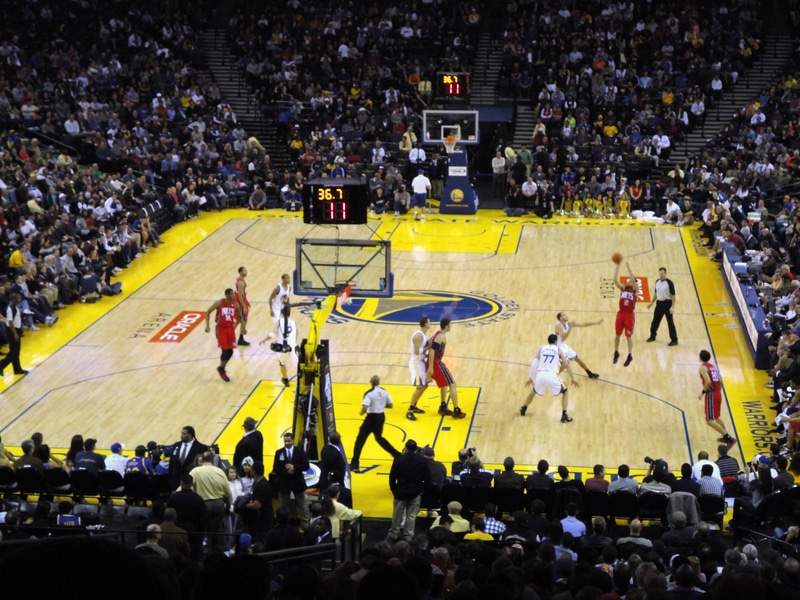Last updated on October 25th, 2023 at 07:49 am
To put it simply, PF means “personal fouls” in basketball. When a player commits a personal foul against another player, it will be scored on their stat sheet. In the NBA, each player is permitted six fouls per game, so keeping track of all personal fouls is essential.
So, what exactly are the types of personal basketball fouls that occur against other players? How often do these fouls occur? And what is the difference between a personal foul and a team foul? Does PF stand for anything else in basketball?
Learn the answer to these questions and more in this comprehensive guide to the term “PF” in basketball.
What are the Types of PF in a Basketball Game?
Two main types of personal fouls can occur during a game of basketball. These are defensive fouls and offensive fouls, though they are both just counted as personal fouls within the basketball stats. Basketball stats may also include marks for total rebounds and the number of points.
Defensive fouls are the most common type of fouls that players have called on them. These occur more often because a player is more likely to foul another player to stop them from scoring. It is much easier to get overly physical while playing defense than offense. Players with many defensive fouls are often seen as physical defenders. If they frequently foul out, they can be known as a player who struggles to not foul on defense.
Offensive personal fouls are much less common, but they are still likely to occur in every basketball game. An offensive foul happens when an offensive player shows aggression toward the opposing team’s player. These offensive fouls may occur when a player tries to get to the goal to score some points against his opponents. Flagrant fouls are another type of foul seen as too physical and unsportsmanlike. It is important to note that technical fouls are not considered personal fouls.
What is an Example of a Personal Foul in Basketball?
When it comes to personal fouls, there are many different ways that they can occur, whether it is during offense or defense. Anytime a player hits, pushes, grabs, kicks, or trips an opponent, they have committed a personal foul. Defensive fouls can include physical contact when the defender unsuccessfully tries to steal the ball or block a shot. Defensive players can’t push back against the person with the ball.
Offensive players can commit a personal foul when they attempt to push past or hold the person guarding them. Illegal screens and charging fouls are also common types of offensive fouls. It is common to commit a foul while going up for a rebound, whether an offensive rebound or a defensive rebound. Flagrant fouls can include hitting or kicking another player, especially when the two are in an altercation.
Shooting fouls are a specific type of offensive foul that happens when a player tries to make a shot. For instance, if the shooting guard was standing behind the three-point line and attempting a three-point field goal, they could shoot three free throws. If the small forward tried to make two points, they would get two free throw shots. However, if the fouled player makes the shot they were attempting, they will get points for that basket, and that player gets to take one extra free throw.
What is the Difference Between a Personal Foul and a Team Foul?
As mentioned above, a personal foul is any foul committed by an individual basketball player. Players will get one tally in their box score each time a player commits a foul. Per NBA rules, if that player reaches six fouls during a game, that player has fouled out and is no longer allowed to play in that game.
A team foul may sound like a foul that the entire team commits together, but that is not the case. A team foul is simply the number of fouls that the team as a whole has committed. For example, if two players have three fouls each, then the team has six.
In the NBA, the number of team fouls resets every quarter so that each team starts each quarter with zero team fouls. If a team reaches five team fouls within a quarter, the other team will get additional free throws for every personal foul after that.
Conclusion: What Does PF Mean in Basketball?
In conclusion, PF refers to a personal foul that occurs during a basketball game. Depending on the foul, the ball possession will change, or the fouled player will be allowed to shoot free throws. Players who commit too many fouls will no longer be allowed to play in that game.
Fouls can include anything from unsuccessfully blocking a shot to an offensive charging call. Though you can expect around 40 fouls in each NBA game, you must also remember that the number of fouls has steadily decreased. A team’s accumulated fouls are called “team fouls” and can result in extra free throws if a team is fouling too much.
Remember: fouls are an essential part of the flow of the game and ensure that the game is fair and clean. Fouls can also affect the plus/minus of each player.
Similar Posts:
What is a Playmaker in Basketball?
What is a Carry in Basketball?
What is a Small Forward in Basketball?
How Many Quarters in Basketball?
What is a Rebound in Basketball?
Greg Kristan, owner of The Stadium Reviews, LLC and TM Blast, LLC, brings his extensive experience visiting over half of the MLB ballparks, along with numerous MLS, NHL, NBA, and NFL venues, to provide in-depth coverage on the bag policy, food options, and parking. He has also been interviewed about his experiences on several sports podcasts.





